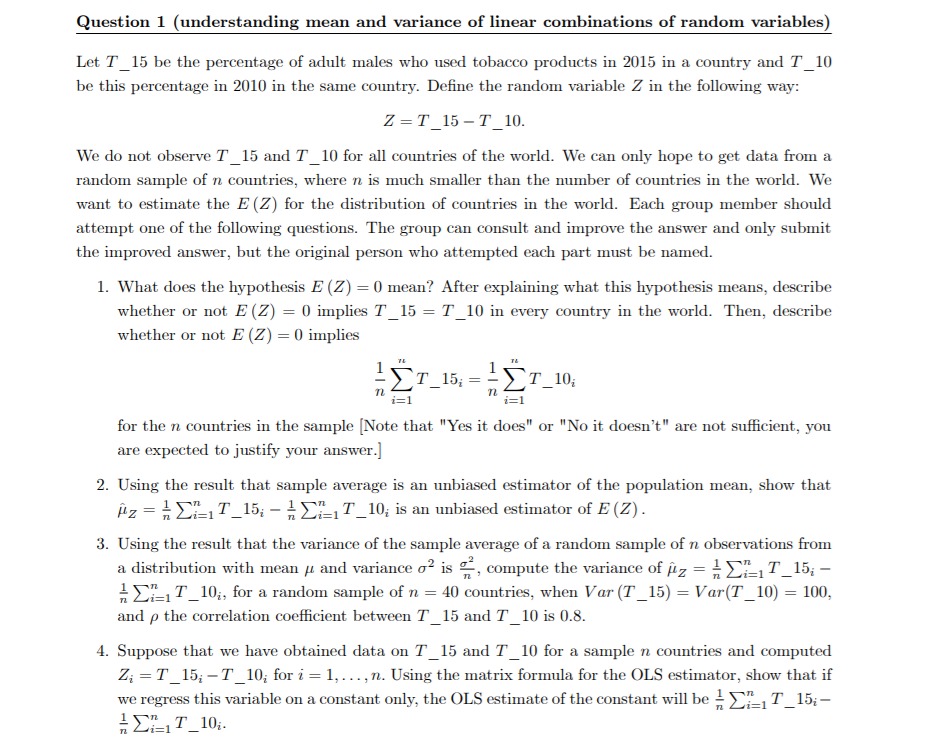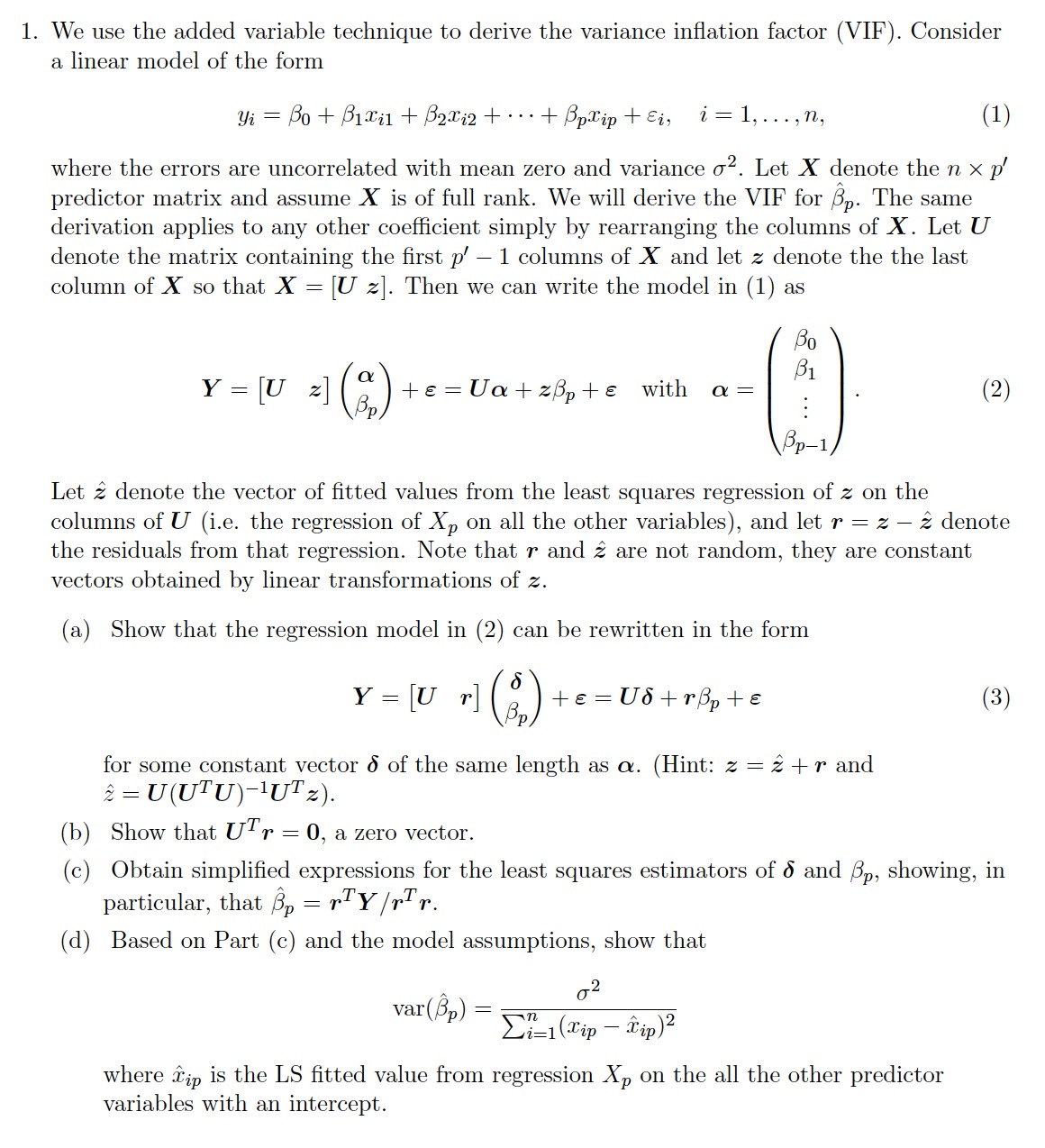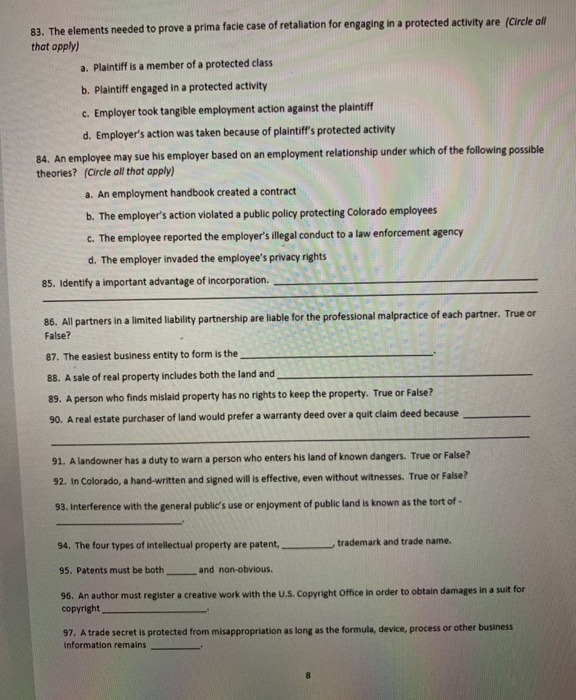


Question 1 (understanding mean and variance of linear combinations of random variables) Let T_15 be the percentage of adult males who used tobacco products in 2015 in a country and T_10 be this percentage in 2010 in the same country. Define the random variable Z in the following way: Z =T_15 -T_10. We do not observe T_15 and T_10 for all countries of the world. We can only hope to get data from a random sample of n countries, where n is much smaller than the number of countries in the world. We want to estimate the E (Z) for the distribution of countries in the world. Each group member should attempt one of the following questions. The group can consult and improve the answer and only submit the improved answer, but the original person who attempted each part must be named. 1. What does the hypothesis E (Z) = 0 mean? After explaining what this hypothesis means, describe whether or not E (Z) = 0 implies T_15 = T_10 in every country in the world. Then, describe whether or not E (Z) = 0 implies -Er_15; = -Er_10; 1= 1 1= 1 for the n countries in the sample [Note that "Yes it does" or "No it doesn't" are not sufficient, you are expected to justify your answer.] 2. Using the result that sample average is an unbiased estimator of the population mean, show that iz = MET_15; - MELT_10; is an unbiased estimator of E (Z) . 3. Using the result that the variance of the sample average of a random sample of n observations from a distribution with mean / and variance o' is , compute the variance of /z = > >_,T_15; - " Ein T_10;, for a random sample of n = 40 countries, when Var (T_15) = Var(T_10) = 100, and p the correlation coefficient between 7_15 and T_10 is 0.8. 4. Suppose that we have obtained data on T_15 and T_10 for a sample n countries and computed Z; =T_15; -T_10; for i = 1, ..., n. Using the matrix formula for the OLS estimator, show that if we regress this variable on a constant only, the OLS estimate of the constant will be ! )_, T_15;- = ELIT_10.Question 1 (understanding mean and variance of linear combinations of random variables) Let T_15 be the percentage of adult males who used tobacco products in 2015 in a country and T_10 be this percentage in 2010 in the same country. Define the random variable Z in the following way: Z =T_15 -T_10. We do not observe T_15 and T_10 for all countries of the world. We can only hope to get data from a random sample of n countries, where n is much smaller than the number of countries in the world. We want to estimate the E (Z) for the distribution of countries in the world. Each group member should attempt one of the following questions. The group can consult and improve the answer and only submit the improved answer, but the original person who attempted each part must be named. 1. What does the hypothesis E (Z) = 0 mean? After explaining what this hypothesis means, describe whether or not E (Z) = 0 implies T_15 = T_10 in every country in the world. Then, describe whether or not E (Z) = 0 implies -Er_15; = -Er_10; 1= 1 1= 1 for the n countries in the sample [Note that "Yes it does" or "No it doesn't" are not sufficient, you are expected to justify your answer.] 2. Using the result that sample average is an unbiased estimator of the population mean, show that iz = MET_15; - MELT_10; is an unbiased estimator of E (Z) . 3. Using the result that the variance of the sample average of a random sample of n observations from a distribution with mean / and variance o' is , compute the variance of /z = > >_,T_15; - " Ein T_10;, for a random sample of n = 40 countries, when Var (T_15) = Var(T_10) = 100, and p the correlation coefficient between 7_15 and T_10 is 0.8. 4. Suppose that we have obtained data on T_15 and T_10 for a sample n countries and computed Z; =T_15; -T_10; for i = 1, ..., n. Using the matrix formula for the OLS estimator, show that if we regress this variable on a constant only, the OLS estimate of the constant will be ! )_, T_15;- = ELIT_10.1. We use the added variable technique to derive the variance ination factor (VIP). Consider a linear model of the form 91' =50+l31$1+l3213922+-"+}3p$a'p+zr, 5'3: 1:"'ana (1) where the errors are uncorrelated with mean zero and variance 02. Let X denote the n X p' predictor matrix and assume X is of full rank. We will derive the VIP for ip. The same derivation applies to any other coefcient simply by rearranging the columns of X. Let U denote the matrix containing the rst p' 1 columns of X and let z denote the the last column of X so that X = [U 2]. Then we can write the model in (1) as 50 x91 Y=[U z](,:J)+t-:=Ua+z6p+e with a: (2) x810. 1 Let 2 denote the vector of tted values from the least squares regression of z on the columns of U (Le. the regression of X.p on all the other variables), and let T : z 2 denote the residuals from that regression. Note that 'r' and 3 are not random, they are constant vectors obtained by linear transformations of z. (a) Show that the regression model in (2) can be rewritten in the form for some constant vector 6 of the same length as a. (Hint: z : i l 'r and 2? = U(UTU)_1UTz). (b) Show that UT? 2 0, a zero vector. (0) Obtain simplied expressions for the least squares estimators of 5 and 5?, showing, in particular, that 5,, : 'rTY/rT'r. (d) Based on Part (c) and the model assumptions, show that 0.2 ELK\"? _ is)? where :Eg-p is the LS tted value from regression X,D on the all the other predictor variables with an intercept. var(,p) : 83. The elements needed to prove a prima facie case of retaliation for engaging in a protected activity are (Circle all that apply) a. Plaintiff is a member of a protected class b. Plaintiff engaged in a protected activity c. Employer took tangible employment action against the plaintiff d. Employer's action was taken because of plaintiff's protected activity 84. An employee may sue his employer based on an employment relationship under which of the following possible theories? (Circle all that apply) a. An employment handbook created a contract b. The employer's action violated a public policy protecting Colorado employees c. The employee reported the employer's illegal conduct to a law enforcement agency d. The employer invaded the employee's privacy rights 85. Identify a important advantage of incorporation. 86. All partners in a limited liability partnership are liable for the professional malpractice of each partner. True or False? 87. The easiest business entity to form is the 88. A sale of real property includes both the land and 89. A person who finds mislaid property has no rights to keep the property. True or False? 90. A real estate purchaser of land would prefer a warranty deed over a quit claim deed because 91. A landowner has a duty to warn a person who enters his land of known dangers. True or False? 92. In Colorado, a hand-written and signed will is effective, even without witnesses. True or False? 93. Interference with the general public's use or enjoyment of public land is known as the tort of - 94. The four types of intellectual property are patent, trademark and trade name. 95. Patents must be both and non-obvious. 95. An author must register a creative work with the U.S. Copyright Office in order to obtain damages in a suit for copyright 97. A trade secret is protected from misappropriation as long as the formula, device, process or other business Information remains












